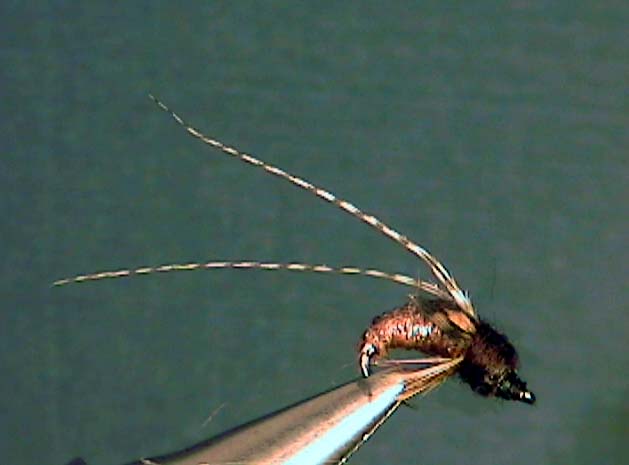Hook Size: 16/18
The Perfect Fly Cinnamon Caddis Pupa trout fly imitates the Cinnamon Caddis larva stage of life. Their larvae live in a case type shelter until the pupa is formed just prior to the hatch. Just prior to the hatch, the pupa comes out of its case and accents from the bottom of the stream to the surface where it emerges into an adult. This makes them easy prey for trout. They should be fished from the bottom to the surface of the water by first allowing the fly to sink to the bottom and then bringing the fly up to the surface using the current and the tip of the rod.
The pupae of the Cinnamon Caddisflies, called Cinnamon Sedges by some
anglers, swim to the surface to hatch. They are fully exposed and very available
for the trout to eat at that time. This is the best time to imitate the Cinnamon
Caddisflies because the pupae are completely defenseless and trout eat them
like humans eat popcorn and peanuts.
The problem with the Cinnamon Caddisfly hatch is being able to determine when
it is actually underway. Often the caddisflies are emerging at the same time they
are depositing their eggs and although this helps in a way, it also confuses the
situation meaning you don’t always know whether to imitate the egg layers of the
emerging pupae. If egg laying activity isn’t taking place, you will probably not
notice the hatch is underway or see the fish feeding on them.
Trout eat the Cinnamon Sedge pupae as they swim (aided by air bubbles) to the
surface. Occasionally the trout will jump completely out of the water eating the
pupae. This is one clue that they are eating the pupae but most of the time all
you will see, if anything, is the swirl of a trout feeding below the surface on the
pupae.
The hatch usually takes place in the late afternoons but later on in the year in
warmer weather, it may not occur until dusk. It all depends on the time of year
that the particular species hatch. The Cinnamon Sedges usually hatch in the
riffles but they can also hatch in smooth flowing streams, runs and some areas of
the pools, depending on the configuration.
Pupae Presentation:
Imitations of the pupae should be presented in the same manner as the larva
imitation except that you would not weight the fly as much. You want the
fly to swing downstream near the bottom and then rise back to the surface to
imitate the naturals.
If you are fishing pocket water streams, it is usually best to use a short, up and
across presentation in the calmer pockets. Allow the fly to sink to the bottom and
then, using the tip of your rod, bring it back to the surface near the current
seams.
If you are fishing riffles and runs, you should make a longer down and across
cast in smooth water. Mend the fly to get it down. Stop the swing of the rod when
the fly is slightly downstream from your position. Hold the rod tip fairly high. If you
determine that they are emerging in a particular area of the riffle or run, then you
would want your fly to end up rising to the surface in that same area. The trout
will usually eat the fly as it rises to the surface. Allow it to sit on the surface for a
econd or two and repeat the cast in a slightly different location.

